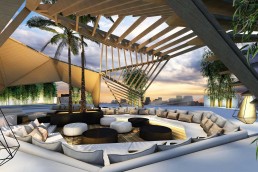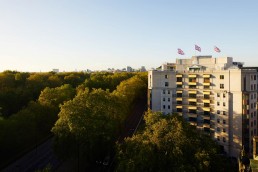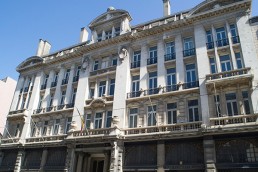Palazzo Portinari Salviati, a symbol of history, art and architecture of the city of Florence, has reopened its doors following a complete renovation carried out by the Milan-based studio Spagnulo & Partners.
Built by the Portinari family, the palace was acquired by Jacopo Salviati, husband of Lucrezia de’ Medici, in 1456. He expanded it and modified it in its present image, as a magnificent specimen of Florentine Renaissance architecture. Amidst courtyards and halls, frescoed ceilings and marble floors, some of the great personalities of the city lived and visited. They have served as inspiration for the interior design by Spagnulo & Partners, enlisteded to convert this monument into a historic property managed by LDC Group, containing 13 suites, 25 apartments, a restaurant and spa.
“The project sets out to create a narrative, which through the personalities pertaining to the Portinari and Salviati families generates a spatial pathway through the streets of Florence, mending ties that have been interrupted across the succession of generations,” says Federico Spagnulo, Founder and Senior Partner of Spagnulo & Partners. “The guests of Beatrice’s palace will be amazed to make the acquaintance of figures unknown to most people today, people who were once the protagonists of episodes that made Florence a truly unique location in the world.”

With the precise aim of conserving heritage and the many stories connected with the building, Spagnulo & Partners worked closely with the master restorers of Faberestauro, in charge of the conservation of the frescoes and exceptional works of art inside the Palazzo, including cycles of frescos made by Alessandro Allori and his team in the Emperor’s Courtyard and Salviati Chapel. The conservative restoration revives the splendour of a place that had been abandoned for years, based on precise historical-artistic research, painstaking diagnostic studies, and a particular focus on local materials and techniques, in tune with the heritage of the site. The restoration has been carried out under the aegis of the Office of Archaeology, Fine-Arts and Landscape of the metropolitan city of Florence and the provinces of Pistoia and Prato.
From the entrance on Viadel Corso, one reaches the Cosimo I Courtyard, which takes its name from the original statue of Cosimo I de’Medici dressed as a Roman emperor at the centre of the space. Furnished with fine period pieces, the courtyard has natural lighting thanks to a glass and steel skylight that can be opened or closed, offering maximum flexibility of use throughout the year. The checked marble flooring, alternating grey Bardiglio and white Carrara marble, is based on the floors seen in the 13th-century fresco of the Madonna and Child, on view in the portico of the courtyard.

Next comes the Emperor’s Courtyard, today hosting the new restaurant by Michelin-star chef Vito Mollica “Chic Nonna”, thus named due to the oval niches that once displayed busts of Roman emperors. The cycle of frescos made by Alessandro Allori and his helpers in 1575-1576, with stories of the Ulysses and stories of Hercules, and the extraordinary frieze of the Batrachomyomachia depicting the battle between frogs and mice narrated in a poem attributed to Homer are of particular value. Also by Allori are the frescoes in the nearby Salviati Chapel, painted between 1580 and 1581 when it was consecrated, a precious testimony to the transformation process that affected sacred painting.
At the piano nobile one reaches the Galleria, where the frescoes have been completely restored. Those on the walls, made by Tommaso Gherardini in 1783, have an architectural approach that reinforces the nave structure of the gallery. The gallery flooring, like that of some of the suites on the same level, is in seminato, a clear reference to the historical tradition typical of Florentine palaces, alternating white Carrara, grey Bardiglio, red Verona and yellow Siena marble, in keeping with the tradition of the Cinquecento.
The five historical suites on the piano nobile, facing Via del Corso, stand out for large windows decorated with the crests of the historic Renaissance guilds. The Master Suite Francesco I De’ Medici and the Dante Alighieri Suite are enhanced by carefully restored Renaissance details, including fireplaces in pietra serena, floors in authentic Tuscan cotto and high coffered ceilings, which in the Francesco I De’ Medici Suite have particular historical importance, since they were made in the 1400s by the Portinari family, bearing its coat of arms.

The same level also contains three frescoed suites, named after Maria de’ Medici, Frederik IV of Denmark and Beatrice Portinari, whose walls and ceilings has been painted by Tommaso Gherardini between 1783 and 1784. The restored images depict the Greek mythological divinities Hypnos, Thanatos and Cybele, and the story of Marcus Curtius, the legendary hero who plunged on horseback into an abyss to save the Roman Empire.
The upper levels offer other suites of the historic palace, and the apartments, featuring Italian herringbone wood floors, panelled ceilings and walls in marmorino, a very old technique involving finishing with Marseille soap. Great attention to detail can be seen in the multi-coloured marble ‘carpets,’ freely based on the complexity and variety of those of the Baptistery of Florence. On the upper level, there is a suite dedicated to Galileo Galilei, featuring wood panelling based on the studies of the great 15th-century thinkers, and furnishings that reference the world of astronomy. The suit offers a 360° view of the city, from the dome of the Baptistery to the tower of Palazzo della Signoria.
Related Posts
11 January 2022
Hilton unveils EMEA openings for 2022
8 December 2021
The Dorchester announces major renovation
17 May 2016



